Aircraft / Attack helicopters / Mi-24 Hind
Mi-24 Hind
General Facts
- TYPE
Attack helicopter - ORIGIN
 USSR
USSR - NICKNAMES
Hind (NATO reporting name)
Stakan (Glass, nickname for Mi-24A)
Krokodil (Crocodile, nickname for all models) - DESIGNED
1968 - 1971 - DESIGNER
Mikhail Leontyevich Mil - PRODUCTION
1972 - present - PRODUCERS
 Russia - Mil
Russia - Mil
 USSR - Mil
USSR - Mil - QUANTITY
Over 2.500 produced - UNIT COST
Unknown - CHARACTERISTICS
 Carries a lot of firepower
Carries a lot of firepower
 Well armored
Well armored
 Ability to transport troops or spares
Ability to transport troops or spares
 Carries mostly limited precision weapons
Carries mostly limited precision weapons
Introduction
The Mi-24 is an attack helicopter of Soviet origin. It was developed in the late 1960s to provide Soviet forces with a similar capability as the US AH-1 Cobra. The Mi-24 is unique in being an attack helicopter with a sizeable troop compartment. Due to its size and armor it is the heaviest attack helicopter in use. The commonly used NATO reporting name for the Mi-24 is Hind.
Layout
The Mi-24 was derived from the successful Mi-8 transport helicopter. It features a distinctive tandem cockpit with the gunner in the front and the pilot at the rear. The troop compartment with large doors on either size is located behind the cockpit and under the two large engines that power the massive five blade main rotor. A large stub wing on either side creates additional lift and three hardpoints. The tricycle landing gear is retractable which aids in streamlining.
Firepower
Most Mi-24 feature a 12.7mm Yak-B minigun in a chin turret while some have a very powerful two barrel 30mm GSh-30K autocannon straddled along the right side of the cockpit. The inner pylons are used to carry unguided rockets such as the 57mm S-5 and 80mm S-8, gun pods such as the UPK-23 and a variety of free fall bombs. The outer pylons are fitted with guided anti-tank missiles such as the AT-2 missiles on early models and AT-6 and AT-9 on later models.
Protection
The armor protection of the Mi-24 is considerable. The fuselage and rotor blades will withstand 12.7mm rounds from any angle. The cockpit is even better protected and will even resist 37mm shells. Many Hinds in current service feature large exhaust diffusers on either side of the engines to reduce IR signature and increase their chance against most MANPADS.
Mobility
Even though the Mi-24 is a very heavy helicopter it is able to reach high speeds due to the enormous power provided by the two 2.200 hp Isotov engines and its streamlined design. At high speeds the stub wings provide up to a quarter of the required lift.
Users
The Mi-24 was the main attack helicopter in Soviet service and was employed in large numbers. In Russian service the Mi-24 remains in widespread use although it is complemented by small numbers of Mi-28 and Ka-50. Export models with downgraded capabilities were exported to most Warsaw Pact members and a wide variety of Soviet allies. The Mi-24 has been used in many conflicts in Africa, Asia and the Middle East.
Hind-A
The Hind-A is the original production version of the Hind and was only produced in 1972. The early production models are easily identified by their stumpy side by side cockpit with large windows. They are armed with MCLOS versions of the AT-2 Swatter and have a 12.7mm UB machine gun in the nose.
Mi-24 Hind-A: The original Soviet version of the Hind.
Mi-24A Hind-B: Similar to Hind-A but lacking 12.7mm UB in nose.
Mi-24U Hind-C: Training version without gun in the nose and lacking outer pylons.
- Specifications:
- Mi-24
| Type | Attack helicopter |
|---|---|
| Crew | 2 + 8 (pilot, gunner, 8 troops) |
| Lenght | ? |
| Width | Wingspan: 6.5 m |
| Height | ? |
| Weight | ? |
| Rotors | Five blade main rotor, four blade tail rotor |
| Diameter | Main: 17.3 m Tail: 3.9 m |
| Disc area | Main: 235 m2 Tail: 12 m2 |
| Chord | ? |
| Powerplant | 2x Isotov TV2-117A turbine, 1.700 hp each |
| Speed | 320 km/h max |
| Range | ? |
|---|---|
| Fuel | ? |
| Climb rate | 15 m/s |
| Ceiling | ? |
| Endurance | ? |
| Landing gear | Retractable tricycle, double front wheels, two single rear wheels |
| Armor | Protected against 12.7mm all around, incl rotor blades, cockpit resistant to 37mm rounds |
| Cargo | 8 troops 4 stretchers spare parts or additional ammunition |
| Avionics | ? |
| Self defense | ? |
| Remarks | - |
| Weapon systems | 12.7mm UB machine gun AT-2 Swatter anti-tank missiles 57mm S-5 rockets 240mm S-24 rockets free fall bombs |
| Fixed weapons | 12.7mm UB machine gun in cockpit |
|---|---|
| Hardpoints | 4 hardpoints, 2 wingtips |
| Option 1 | AT-2 Swatter (MCLOS) anti-tank missile 2 missiles on each wingtip |
| Option 2 | S-5 rockets in 16 round UV-16 or 32 round UV-32 rocket pod on each hardpoint |
| Option 3 | S-24 rocket on each hardpoint |
| Option 4 | FAB-250 bomb, KMGU dispenser or 4x FAB-100 bomb on each hardpoint |
| Option 5 | - |
| Option 6 | - |
| Option 7 | - |
| Option 8 | - |
Hind-D
The Mi-24D is much more common than all previous versions. It entered production in 1973, only a year after the Mi-24 was accepted for service. The Mi-24D is the first version to use the new forward fuselage and cockpit design. It has a Yak-B minigun in a chin turret and uses the SACLOS version of the AT-2 Swatter anti-tank missile.
Mi-24D Hind-D: The original Soviet version of the Hind-D.
Mi-25 Hind-D: The export version of the Mi-24 is called the Mi-25.
- Specifications:
- Mi-24D
| Type | Attack helicopter |
|---|---|
| Crew | 2 + 8 (pilot, gunner, 8 troops) |
| Lenght | Fuselage: 17.5 m Rotors turning: 21.6 m |
| Width | Wingspan: 6.5 m |
| Height | 6.5 m |
| Weight | Empty: 8.4 t Normal: 11.1 t MTOW: 11.5 t |
| Rotors | Five blade main rotor, three blade tail rotor |
| Diameter | Main: 17.3 m Tail: 3.9 m |
| Disc area | Main: 235 m2 Tail: 12 m2 |
| Chord | ? |
| Powerplant | 2x Isotov TV3-117 turbine, 2.200 hp each |
| Speed | 335 km/h max 295 km/h cruise |
| Range | 450 km range 950 km range with auxilary fuel |
|---|---|
| Fuel | 1.840 L internal 500 L tanks on each hardpoint |
| Climb rate | 15 m/s |
| Ceiling | 4.5 km |
| Endurance | ? |
| Landing gear | Retractable tricycle, double front wheels, two single rear wheels, 4.39 m wheelbase, 3.03 m track |
| Armor | Protected against 12.7mm all around, incl rotor blades, cockpit resistant to 37mm rounds |
| Cargo | 8 troops 4 stretchers spare parts or additional ammunition |
| Avionics | Standard flight controls, electro optical sight, IFF system |
| Self defense | Radar warning receiver, IR jammer, flares, optional heat diffusers |
| Remarks | - |
| Weapon systems | 12.7mm Yak-B minigun AT-2 Swatter anti-tank missiles 57mm S-5 rockets 240mm S-24 rockets GUV gun pod UPK-23 gun pod free fall bombs |
| Fixed weapons | 12.7mm Yak-B minigun in chin turret with 1.470 rounds |
|---|---|
| Hardpoints | 4 hardpoints, 2 wingtips |
| Option 1 | AT-2 Swatter (SACLOS) anti-tank missile 2 missiles on each wingtip |
| Option 2 | S-5 rockets in 16 round UV-16 or 32 round UV-32 rocket pod on each hardpoint |
| Option 3 | S-24 rocket on each hardpoint |
| Option 4 | UPK-23 or GUV gun pod on each hardpoint |
| Option 5 | FAB-250 bomb, KMGU dispenser or 4x FAB-100 bomb on each hardpoint |
| Option 6 | - |
| Option 7 | - |
| Option 8 | - |
Hind-E
The Mi-24V Hind-E is a further evolution of the Mi-24D. It entered production in 1976 and is the most numerous version of the Hind. Its main improvement is its ability to fire the AT-6 Spiral anti-tank missile which is much more capable than the AT-2 Swatter used in previous versions.
Mi-24V Hind-E: The original Soviet version of the Hind-E.
Mi-24VP Hind-E: Mi-24V with twin 23mm cannon in nose turret, only 25 produced.
Mi-35 Hind-E:The export version of the Hind-D.
- Specifications:
- Mi-35
| Type | Attack helicopter |
|---|---|
| Crew | 2 + 8 (pilot, gunner, 8 troops) |
| Lenght | Fuselage: 17.51 m Rotors turning: 21.35 m |
| Width | Wingspan: 6.5 m |
| Height | 6.5 m |
| Weight | Empty: 8.5 t MTOW: 12.0 t |
| Rotors | Five blade main rotor, three blade tail rotor |
| Diameter | Main: 17.30 m Tail: 3.91 m |
| Disc area | Main: 235 m2 Tail: 12 m2 |
| Chord | ? |
| Powerplant | 2x Isotov TV3-117 turbine, 2.200 hp each |
| Speed | 335 km/h max |
| Range | 450 km range |
|---|---|
| Fuel | 1.840 L internal 500 L tanks on each hardpoint |
| Climb rate | 12.5 m/s |
| Ceiling | 4.5 km |
| Endurance | ? |
| Landing gear | Retractable tricycle, double front wheels, two single rear wheels, 4.39 m wheelbase, 3.03 m track |
| Armor | Protected against 12.7mm all around, incl rotor blades, cockpit resistant to 37mm rounds |
| Cargo | 8 troops 4 stretchers spare parts or additional ammunition |
| Avionics | Standard flight controls, electro optical sight, IFF system |
| Self defense | Radar warning receiver, IR jammer, flares, optional heat diffusers |
| Remarks | - |
| Weapon systems | 12.7mm Yak-B minigun AT-6 Spiral anti-tank missiles 57mm S-5 rockets 80mm S-8 rockets 122mm S-13 rockets 240mm S-24 rockets GUV gun pod UPK-23 gun pod free fall bombs |
| Fixed weapons | 12.7mm Yak-B minigun in chin turret with 1.470 rounds |
|---|---|
| Hardpoints | 4 hardpoints, 2 wingtips |
| Option 1 | AT-6 Spiral anti-tank missile, 2 missiles on each wingtip or outer hardpoint |
| Option 2 | S-5 rockets in 16 round UV-16 or 32 round UV-32 rocket pod on each hardpoint |
| Option 3 | S-8 rockets in 20 round B-8V20 rocket pod on each hardpoint |
| Option 4 | S-13 rockets in 5 round B-13 rocket pod on each hardpoint |
| Option 5 | S-24 rocket on each hardpoint |
| Option 6 | UPK-23 or GUV gun pod on each hardpoint |
| Option 7 | FAB-250 bomb, KMGU dispenser or 4x FAB-100 bomb on each hardpoint |
| Option 8 | - |
Hind-F
The Mi-24P is similar to the Mi-24V but differs in cannon armament. Whereas the Mi-24V is armed with a 12.7mm Yak-B minigun in a nose turret the Mi-24P has a twin barrel 30mm GSh-30K autocannon alongside the cockpit. The GSh-30K is much more powerful but not as simple to aim as the Yak-B. The P in the designation stands for Pushka, which is Russian for cannon.
Mi-24P Hind-F: The original Soviet army version of the Hind-F.
Mi-35P Hind-F: The export version of the Hind-F.
- Specifications:
- Mi-24P
| Type | Attack helicopter |
|---|---|
| Crew | 2 + 8 (pilot, gunner, 8 troops) |
| Lenght | Fuselage: 17.51 m Rotors turning: 21.35 m |
| Width | Fuselage: 1.70 m Wingspan: 6.66 m |
| Height | 3.97 m |
| Weight | Empty: 8.20 t Normal: 11.2 t MTOW: 12.0 t |
| Rotors | Five blade main rotor, three blade tail rotor |
| Diameter | Main: 17.30 m Tail: 3.91 m |
| Disc area | Main: 235 m2 Tail: 12.0 m2 |
| Chord | Main: 0.58 m |
| Powerplant | 2x Isotov TV3-117 turbine, 2.200 hp each |
| Speed | 335 km/h max 270 km/h cruise 217 km/h economical |
| Range | 160 km combat radius 288 km combat radius with 4 fuel tanks 500 km range 1.000 km range with four fuel tanks |
|---|---|
| Fuel | 1.840 L internal 500 L tanks on each hardpoint |
| Climb rate | 12.5 m/s |
| Ceiling | 4.5 km |
| Endurance | 4 hours |
| Landing gear | Retractable tricycle, double front wheels, two single rear wheels, 4.39 m wheelbase, 3.03 m track |
| Armor | Protected against 12.7mm all around, incl rotor blades, cockpit resistant to 37mm rounds |
| Cargo | 8 troops 4 stretchers spare parts or additional ammunition |
| Avionics | Standard flight controls, electro optical sight, IFF system |
| Self defense | Radar warning receiver, IR jammer, flares, optional heat diffusers |
| Remarks | - |
| Weapon systems | 30mm GSh-30K autocannon AT-6 Spiral anti-tank missiles 57mm S-5 rockets 80mm S-8 rockets 122mm S-13 rockets 240mm S-24 rockets GUV gun pod UPK-23 gun pod free fall bombs |
| Fixed weapons | 30mm GSh-30K along fuselage with 750 rounds |
|---|---|
| Hardpoints | 4 hardpoints, 2 wingtips |
| Option 1 | AT-6 Spiral anti-tank missile, 2 missiles on each wingtip or outer hardpoint |
| Option 2 | S-5 rockets in 16 round UV-16 or 32 round UV-32 rocket pod on each hardpoint |
| Option 3 | S-8 rockets in 20 round B-8V20 rocket pod on each hardpoint |
| Option 4 | S-13 rockets in 5 round B-13 rocket pod on each hardpoint |
| Option 5 | S-24 rocket on each hardpoint |
| Option 6 | UPK-23 or GUV gun pod on each hardpoint |
| Option 7 | FAB-250 bomb, KMGU dispenser or 4x FAB-100 bomb on each hardpoint |
| Option 8 | - |
Hind-G
The Hind-G models are reconnaissance models that retain most of their combat capability except for anti-tank missiles. They are fitted with additional sensors and their crew compartment is fitted with mission specific equipment.
Mi-24R Hind-G1: The Mi-24R, RkhR, RA and RR are NBC reconnaissance models with additional sensors. Total of about 120 models built between 1983 and 1989.
Mi-24K Hind-G2: The Mi-24K is an artillery observation version with additional sensors and a camera in the troop compartment. The K stands for korrektirovchik, which is Russian for corrector. About 120 built between 1983 and 1989.
- Specifications:
- Mi-24K
| Type | Reconnaissance helicopter |
|---|---|
| Crew | 2 + 8 (pilot, gunner, 8 troops) |
| Lenght | Fuselage: 17.5 m Rotors turning: 21.6 m |
| Width | Wingspan: 6.5 m |
| Height | 6.5 m |
| Weight | Empty: 9 t Normal 11 t MTOW 12 t |
| Rotors | Five blade main rotor, three blade tail rotor |
| Diameter | Main: 17.3 m Tail: 3.9 m |
| Disc area | Main: 235 m2 Tail: 12 m2 |
| Chord | ? |
| Powerplant | 2x Isotov TV3-117 turbine, 2.200 hp each |
| Speed | 335 km/h max |
| Range | 450 km range |
|---|---|
| Fuel | 1.840 L internal 500 L tanks on each hardpoint |
| Climb rate | 12.5 m/s |
| Ceiling | 4.5 km |
| Endurance | ? |
| Landing gear | Retractable tricycle, double front wheels, two single rear wheels, 4.39 m wheelbase, 3.03 m track |
| Armor | Protected against 12.7mm all around, incl rotor blades, cockpit resistant to 37mm rounds |
| Cargo | ? |
| Avionics | Standard flight controls, electro optical sight, IFF system |
| Self defense | Radar warning receiver, IR jammer, flares, optional heat diffusers |
| Remarks | - |
| Weapon systems | 12.7mm Yak-B minigun 57mm S-5 rockets 240mm S-24 rockets GUV gun pod UPK-23 gun pod free fall bombs |
| Fixed weapons | 12.7mm Yak-B minigun in chin turret with 1.470 rounds |
|---|---|
| Hardpoints | 4 hardpoints |
| Option 1 | S-5 rockets in 16 round UV-16 or 32 round UV-32 rocket pod on each hardpoint |
| Option 2 | S-24 rocket on each hardpoint |
| Option 3 | UPK-23 or GUV gun pod on each hardpoint |
| Option 4 | FAB-250 bomb, KMGU dispenser or 4x FAB-100 bomb on each hardpoint |
| Option 5 | - |
| Option 6 | - |
| Option 7 | - |
| Option 8 | - |
Night attack versions
With the development of the Mi-28 many technologies were developed that could also be used to improve the Mi-24, especially its night fighting ability. The extensive Mi-24VM and PM upgrade programmes never materialized, but some less ambitious variants were developed. The night attack models can be identified by their use of the two hardpoint Mi-28 stub wings, Mi-28 rotors and additional sensors on the chin. The Mi-24PN in Russian service are converted from existing Mi-24Ps, while the export versions are produced new.
Mi-24PN: The Mi-24PN is a much improved Mi-24P. The PN upgrade adds a TV and FLIR camera to the nose, uses rotor blades and the stub wings of the Mi-28 and it has a fixed landing gear.
Mi-35M: Export version of Mi-24PN with different sensor setup, also known as Mi-35M1.
Mi-35M2: Mi-35M with GSh-23-2 cannon in chin mount. Known as the Caribe in Venezuelan use.
| Type | Attack helicopter |
|---|---|
| Crew | 2 + 8 (pilot, gunner, 8 troops) |
| Lenght | Fuselage: 17.51 m Rotors turning: 21.27 m |
| Width | Fuselage: 1.70 m Wingspan: 5.06 m |
| Height | 3.97 m |
| Weight | Empty: 8.05 t Normal: 11.2 t MTOW: 12.0 t |
| Rotors | Five blade main rotor, four blade tail rotor |
| Diameter | Main: 17.20 m Tail: 3.84 m |
| Disc area | Main: 232 m2 Tail: 11.6 m2 |
| Chord | ? |
| Powerplant | 2x Isotov TV3-117 turbine, 2.200 hp each |
| Speed | 312 km/h max 260 km/h cruise |
| Range | 416 km range 1.085 km range with four fuel tanks |
|---|---|
| Fuel | 1.840 L internal 500 L tanks on each hardpoint |
| Climb rate | 12.4 m/s |
| Ceiling | 5.8 km |
| Endurance | ? |
| Landing gear | Fixed tricycle, double front wheels, two single rear wheels, 4.4 m wheelbase, 3.0 m track |
| Armor | Protected against 12.7mm all around, incl rotor blades, cockpit resistant to 37mm rounds |
| Cargo | 8 troops 4 stretchers spare parts or additional ammunition |
| Avionics | Standard flight controls, electro optical sight, IFF system, FLIR system |
| Self defense | Radar warning receiver, IR jammer, flares, optional heat diffusers |
| Remarks | - |
| Weapon systems | 12.7mm Yak-B minigun AT-6 Spiral anti-tank missiles AT-9 Spiral-2 anti-tank missiles 57mm S-5 rockets 80mm S-8 rockets 122mm S-13 rockets 240mm S-24 rockets GUV gun pod UPK-23 gun pod free fall bombs |
| Fixed weapons | 12.7mm Yak-B minigun in chin turret with 1.470 rounds |
|---|---|
| Hardpoints | 4 hardpoints |
| Option 1 | AT-6 Spiral anti-tank missile, 8 missiles on each outer hardpoint |
| Option 2 | AT-9 Spiral-2 anti-tank missile, 8 missiles on each outer hardpoint |
| Option 3 | S-5 rockets in 16 round UV-16 or 32 round UV-32 rocket pod on each hardpoint |
| Option 4 | S-8 rockets in 20 round B-8V20 rocket pod on each hardpoint |
| Option 5 | S-13 rockets in 5 round B-13 rocket pod on each hardpoint |
| Option 6 | S-24 rocket on each hardpoint |
| Option 7 | UPK-23 or GUV gun pod on each hardpoint |
| Option 8 | FAB-250 bomb, KMGU dispenser or 4x FAB-100 bomb on each hardpoint |
| Type | Attack helicopter |
|---|---|
| Crew | 2 + 8 (pilot, gunner, 8 troops) |
| Lenght | Fuselage: 17.51 m Rotors turning: 21.27 m |
| Width | Fuselage: 1.70 m Wingspan: 5.06 m |
| Height | 3.97 m |
| Weight | Empty: 8 t Normal: 11 t MTOW: 12 t |
| Rotors | Five blade main rotor, four blade tail rotor |
| Diameter | Main: 17.20 m Tail: 3.84 m |
| Disc area | Main: 232 m2 Tail: 11.6 m2 |
| Chord | ? |
| Powerplant | 2x Isotov TV3-117 turbine, 2.200 hp each |
| Speed | 312 km/h max 260 km/h cruise |
| Range | 416 km range 1.085 km range with four fuel tanks |
|---|---|
| Fuel | 1.840 L internal 500 L tanks on each hardpoint |
| Climb rate | 12.4 m/s |
| Ceiling | 5.8 km |
| Endurance | ? |
| Landing gear | Fixed tricycle, double front wheels, two single rear wheels, 4.4 m wheelbase, 3.0 m track |
| Armor | Protected against 12.7mm all around, incl rotor blades, cockpit resistant to 37mm rounds |
| Cargo | 8 troops 4 stretchers spare parts or additional ammunition |
| Avionics | Standard flight controls, electro optical sight, IFF system, FLIR system |
| Self defense | Radar warning receiver, IR jammer, flares, optional heat diffusers |
| Remarks | - |
| Weapon systems | 23mm GSh-23-2 autocannon AT-6 Spiral anti-tank missiles AT-9 Spiral-2 anti-tank missiles 57mm S-5 rockets 80mm S-8 rockets 122mm S-13 rockets 240mm S-24 rockets GUV gun pod UPK-23 gun pod free fall bombs |
| Fixed weapons | 23mm GSh-23-2 autocannon in chin turret with 470 rounds |
|---|---|
| Hardpoints | 4 hardpoints |
| Option 1 | AT-6 Spiral anti-tank missile, 8 missiles on each outer hardpoint |
| Option 2 | AT-9 Spiral-2 anti-tank missile, 8 missiles on each outer hardpoint |
| Option 3 | S-5 rockets in 16 round UV-16 or 32 round UV-32 rocket pod on each hardpoint |
| Option 4 | S-8 rockets in 20 round B-8V20 rocket pod on each hardpoint |
| Option 5 | S-13 rockets in 5 round B-13 rocket pod on each hardpoint |
| Option 6 | S-24 rocket on each hardpoint |
| Option 7 | UPK-23 or GUV gun pod on each hardpoint |
| Option 8 | FAB-250 bomb, KMGU dispenser or 4x FAB-100 bomb on each hardpoint |

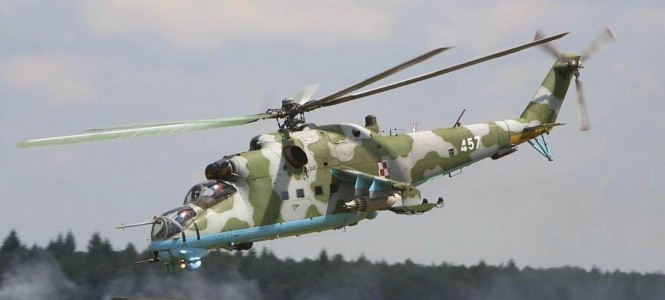
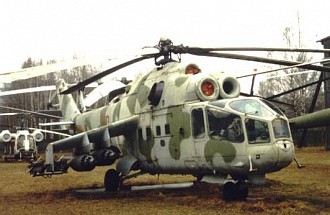
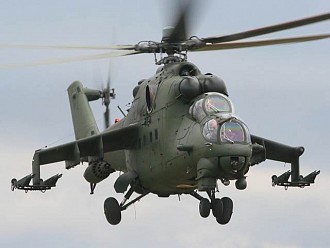
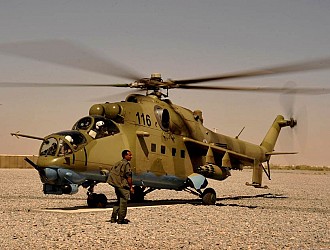
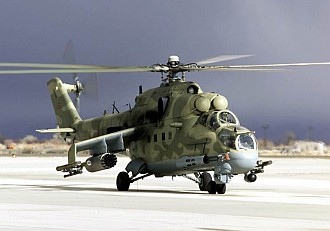

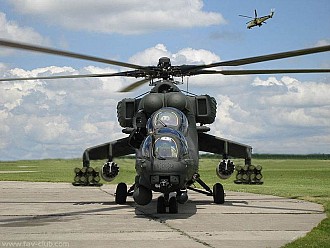
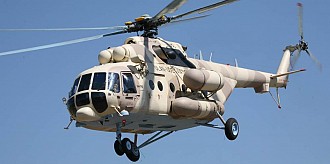

/--/img/ws/msl_atm_at6_o1.jpg)
/--/img/ws/msl_agm_s8_o1.jpg)